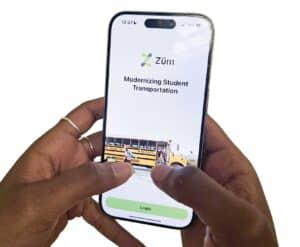
Boston Public Schools continued to face bus transportation delays after implementing a new tracking app, district officials said during a press conference last week.
The mobile app, called Zum, was introduced to improve the transportation system used by tens of thousands of students across Boston but contributed to poor on-time arrivals at the start of the school year and in the following weeks.
“Sometimes we’ve taken a step back to go two steps forward,” said BPS Superintendent Mary Skipper during the briefing outside the Higginson-Lewis K-8 School in Roxbury.
Skipper said bus delays are a “historic issue” in Boston, and this year isn’t the first time the city has faced mediocre on-time arrival performance.
“This has always been the case with us. We’re striving to close that gap so that we can actually get closer to all students arriving on time,” she said.
This year, just one-third of buses were on time for the first day of school, the Boston Globe reported, down from nearly two-thirds last year, affecting most of the 22,336 students who rely on the yellow buses for transportation to school. That number includes 4,736 non-BPS students who attend charter schools or certain non-district special education placements and 17,600 BPS students, or about 35% of the BPS student body, Mayor Michelle Wu wrote in her newsletter last week.
Officials attributed the dismal on-time arrival rate to the rocky implementation of Zum, the bus tracker app that allows parents to view their children’s bus assignments, receive delay notifications and follow bus rides in real time. Bus drivers also use the app as a GPS to navigate their routes and view pick-up and drop-off locations.
Despite previously reporting a successful pilot of the app, officials hit unexpected roadblocks. On the first day of school, about 88% of drivers were using the app, school officials said. By the end of the first week, that number was up to about 96%. However, as of last week, only 9,500 parents and about 13,000 students were using the app. That is still short of the city’s goal, Skipper said, but sufficient for officials to begin collecting useful data.
The BPS transportation department has always had officers working behind the scenes to add students to the bus routes, but Zum offers the ability to generate real-time traffic data from buses on the road, said BPS executive director of transportation Daniel Rosengard. This allows BPS to update its busing model and adjust its routes to minimize, and eventually eradicate, delays.
Officials said that every Tuesday, BPS will make adjustments to its bus assignments by using the data within Zum to examine which routes have the latest arrival times, which ones require more buffer time and whether there is a better route bus drivers could be taking.
On top of the implementation of a new app, Skipper pointed to infrastructural issues as an additional reason for the delays. Bus drivers in Boston face challenges in navigating narrow roads and traffic that worsens as the morning progresses, she said.
“As the app gets smarter and smarter about Boston streets, we should continue to see those roads become more and more efficient,” said Skipper, who added that the district wants to “embrace the technology, the AI, as a way to get to that efficiency and get every student to school on time.”
Parents were notified of the app during the third week of August before the school year began and as officials began planning their bus assignments. BPS Transportation has continued to work with the schools to encourage families to use the app, supplying them with the relevant information they need to onboard, Skipper said.
Parents can sign up for Zum at bostonpublicschools.org/transportation, where they can also find a demonstration video and instructions on logging in.
The transportation department also has had to contend with parents not cancelling bus pickups when they don’t need them, which means bus drivers might wait at a stop when no pickup is necessary. Now, in the app, parents are able to cancel their bus rides, which will notify the driver, allowing them to bypass the stop and cut back on late arrivals.
As usage of the app continues, the city will be able to use the available data to determine the exact location of delays and subsequently take steps to address them. For example, the city would adjust striping or signage to facilitate the drop-off process or assign a traffic officer to direct traffic at intersections near drop-off sites.
“Every little step that we can take from the transportation side, our streets team will make those adjustments,” Mayor Wu said during the press conference. She added that the information gathered from Zum “will allow us to really fine-tune what we’re doing, and it’s all hands on deck across the entire city to help support BPS and our students.”







